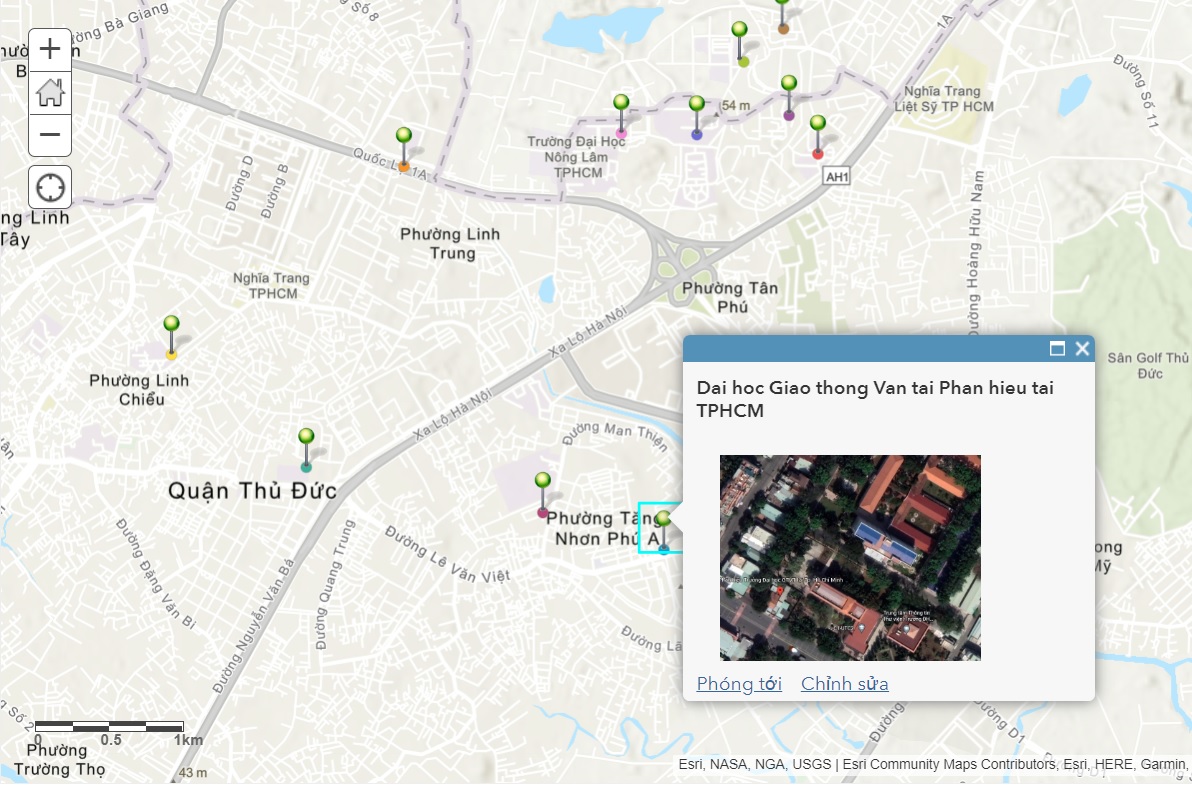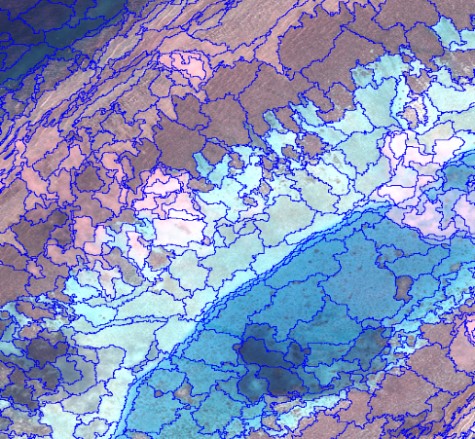02. THE RELATIONSHIP BETWEEN LST, NDVI AND NDBI INDICATORS, AN INVESTIGATION USING LANDSAT IMAGES IN HOA BINH, VIETNAM
Giới thiệu
The study uses Landsat 8 OLI-TIRS satellite images to extract indices and Pearson correlation analysis techniques to evaluate the correlation in the distribution between land surface temperature LST), vegetation index (NDVI), normalized difference built-up index (NDBI) in Hoa Binh province. The results indicate that areas with expansion and increased density of impermeable surfaces are characteristic causes contributing to increased temperatures in urban areas compared to surrounding areas and tend to be 5 - 7 °C higher than the average temperature of the entire study area. The correlation coefficient values reached r = - 0.96791, r = 0.9628, and r = -0.9352 for the relationship between LST-NDVI, LST-NDBI, and NDVI-NDBI respectively. The study results show inter-relationships and transformations of the three indicators in the research context, where urban land temperature and Urban Heat Island (UHI) are raised by built-up areas and in contrast, reduced by vegetated areas. As a result, urban green space would be a driver to mitigate the harmful impact of the "heat island" effect in urban areas. Aim to strengthen concentrated green areas and vegetation in land areas that are less favorable for construction.
Toàn văn bài báo
Trích dẫn
[2]. Li, Z. L., Tang, B. H., Wu, H., Ren, H., Yan, G., Wan, Z., ... & Sobrino, J. A., (2013). Satellite-derived land surface temperature: Current status and perspectives. Remote Sensing of Environment, 131, 14-37.
[3]. Qin, Z., Karnieli, A., & Berliner, P., (2001). A mono-window algorithm for retrieving land surface temperature from Landsat TM data and its application to the Israel-Egypt border region. International Journal of Remote Sensing, 22(18), 3719-3746.
[4]. Jimenez-Munoz, J. C., Cristobal, J., Sobrino, J. A., Sòria, G., Ninyerola, M., & Pons, X., (2008). Revision of the single-channel algorithm for land surface temperature retrieval from Landsat thermal-infrared data. IEEE Transactions on Geoscience and Remote Sensing, 47(1), 339-349.
[5]. Jiménez‐Muñoz, J. C., & Sobrino, J. A., (2003). A generalized single‐channel method for retrieving land surface temperature from remote sensing data. Journal of Geophysical Research: Atmospheres, 108(D22).
[6]. Barsi, J. A., Barker, J. L., & Schott, J. R., (2003). An atmospheric correction parameter calculator for a single thermal band earth-sensing instrument. In IGARSS 2003. 2003 IEEE International Geoscience and Remote Sensing Symposium. Proceedings (IEEE Cat. No. 03CH37477) (Vol. 5, p. 3014-3016). IEEE.
[7]. Barsi, J. A., Schott, J. R., Palluconi, F. D., & Hook, S. J., (2005). Validation of a web-based atmospheric correction tool for single thermal band instruments. In Earth Observing Systems X (Vol. 5882, p. 136-142). SPIE.
[8]. Zhengming, W., & Dozier, J., (1989). Land-surface temperature measurement from space: Physical principles and inverse modeling. IEEE Transactions on Geoscience and Remote Sensing, 27(3), 268-278.
[9]. Tran Thi Van, Hoang Thai Thai & Le Van Trung (2009). Thermal remote sensing method in studying urban surface temperature distribution. Journal of Earth Sciences, No. 31, Volume 2, 168-177.
[10]. Boori, M. S., Vozenílek, V., Balter, H., & Choudhary, K., (2015). Land surface temperature with land cover classes in Aster and Landsat data. Journal of Remote Sensing & GIS, 4(1), 1-4.
[11]. Jaber, S. M., (2021). On the relationship between normalized difference vegetation index and land surface temperature: MODIS-based analysis in a semi-arid to arid environment. Geocarto International, 36(10), 1117-1135.
[12]. Alademomi, A. S., Okolie, C. J., Daramola, O. E., Agboola, R. O., & Salami, T. J., (2020). Assessing the relationship of LST, NDVI, and EVI with land cover changes in the Lagos Lagoon environment. Quaestiones Geographicae, 39(3), 111-123.
[13]. Sandholt, I., Rasmussen, K., & Andersen, J., (2002). A simple interpretation of the surface temperature/vegetation index space for assessment of surface moisture status. Remote Sensing of Environment, 79(2-3), 213-224.
[14]. Hu, Y., & Jia, G., (2010). Influence of land use change on urban heat island derived from multi‐sensor data. International Journal of Climatology, 30(9), 1382-1395.
[15]. Li, W., Cao, Q., Lang, K., & Wu, J., (2017). Linking potential heat source and sink to urban heat island: Heterogeneous effects of landscape pattern on land surface temperature. Science of the Total Environment, 586, 457-465.
[16]. Weng, Q., Lu, D., & Schubring, J., (2004). Estimation of land surface temperature-vegetation abundance relationship for urban heat island studies. Remote sensing of Environment, 89(4), 467-483.
[17]. Choudhury, D., Das, K., & Das, A., (2019). Assessment of land use land cover changes and its impact on variations of land surface temperature in Asansol-Durgapur Development Region. The Egyptian Journal of Remote Sensing and Space Science, 22(2), 203-218.
[18]. Guha, S., Govil, H., Gill, N., & Dey, A., (2020). Analytical study on the relationship between land surface temperature and land use/land cover indices. Annals of GIS, 26(2), 201-216.
[19]. Das, N., Mondal, P., Sutradhar, S., & Ghosh, R., (2021). Assessment of variation of land use/land cover and its impact on land surface temperature of Asansol subdivision. The Egyptian Journal of Remote Sensing and Space Science, 24(1), 131-149.
[20]. Pettorelli, N., Ryan, S., Mueller, T., Bunnefeld, N., Jędrzejewska, B., Lima, M., & Kausrud, K., (2011). The Normalized Difference Vegetation Index (NDVI): unforeseen successes in animal ecology. Climate Research, 46(1), 15-27.
[21]. Eastman, J. R., Sangermano, F., Machado, E. A., Rogan, J., & Anyamba, A., (2013). Global trends in seasonality of normalized difference vegetation index (NDVI), 1982-2011. Remote Sensing, 5(10), 4799-4818.
[22]. Jacquemart, M., & Tiampo, K., (2021). Leveraging time series analysis of radar coherence and normalized difference vegetation index ratios to characterize the pre-failure activity of the Mud Creek landslide, California. Natural Hazards and Earth System Sciences, 21(2), 629-642.
[23]. Zhou, Y., Yang, G., Wang, S., Wang, L., Wang, F., & Liu, X., (2014). A new index for mapping built-up and bare land areas from Landsat-8 OLI data. Remote Sensing Letters, 5(10), 862-871.
[24]. Department of the Interior - U.S. Geological Survey (2019). Landsat 8 (L8) Data Users Handbook. LSDS-1574 Version 5.0. EROS Sioux Falls, South Dakota.
[25]. Hartoyo, A. P. P., SUNKAR, A., RAMADANI, R., FALUTHI, S., & HIDAYATI, S. (2021). Normalized difference vegetation index (NDVI) analysis for vegetation cover in Leuser Ecosystem Area, Sumatra, Indonesia. Biodiversitas Journal of Biological Diversity, 22(3).
[26] Zha, Y., Gao, J., & Ni, S., (2003). Use of normalized difference built-up index in automatically mapping urban areas from TM imagery. International journal of remote sensing, 24(3), 583-594.





